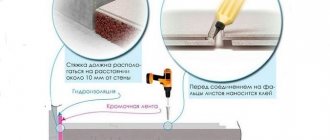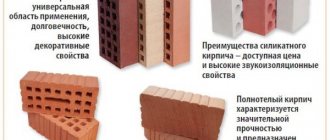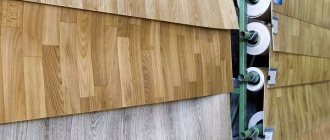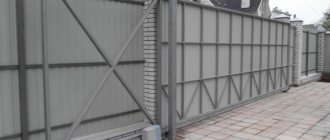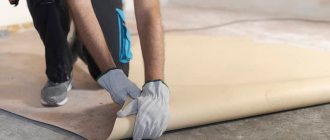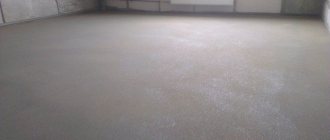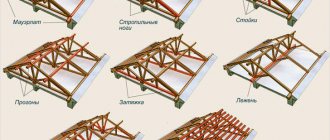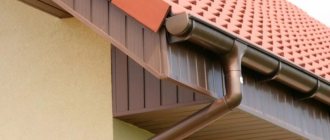Previously, linoleum was chosen as a budget option for flooring, but those days are long gone. Technologies have changed and linoleum today is a safe, unpretentious, inexpensive material with a variety of characteristics. Synthetic or natural, homogeneous or heterogeneous, rough or smooth to the touch, reproducing the texture of natural materials or with abstract designs - there is a choice! All that remains is to understand this diversity, choose the best option and lay it correctly. Then the linoleum will serve you faithfully for many years.
Structure. Homogeneous and heterogeneous. What is the difference?
Homogeneous linoleum is single-layer. This is a canvas with a thickness of 1.5 - 3 millimeters, the pattern on which is applied throughout the entire thickness and the “inside” is the same as the “outside”. Therefore, it is less susceptible to abrasion, and in order to return the linoleum to a fresh look, it needs to be sanded. This procedure can be repeated several times as needed. Manufacturers promise that if the rules of installation and operation are followed, homogeneous linoleum will last up to 25 years. Homogeneous linoleum is used in rooms with high traffic, and where carts, wheelchairs, and strollers are moved along the floor. For example, in supermarkets, airports, clinics, corridors. The design of such linoleum can be simple: plain or with a simple pattern. Sold in rolls 2 meters wide. Does not have a backing. When laying, you can combine different colors and get patterns or brand logos.
It is important to know
The price of homogeneous linoleum directly depends on the quality. Manufacturers add fillers to PVC: limestone or talc. Over time, the polymer layer of the laminate becomes thinner, and the filler begins to attract dust and dirt. Then sloppy mud paths appear on the surface of the linoleum. The more filler in linoleum, the lower the price. Responsible manufacturers apply additional polyurethane protection. Do not buy cheap linoleum from unknown manufacturers if you want to use linoleum for a long time.
Heterogeneous linoleum is made on the basis of fiberglass and contains from 2 to 6 layers. The thickness of such linoleum is up to 6 mm. During the manufacturing process, a layer of PVC mass is applied to reinforcing fiberglass impregnated with PVC paste, then a pattern and a final layer - a polyurethane or PVC film. The stronger and thicker the film, the longer the top layer will not be erased and the longer the linoleum will retain its presentable appearance. Does not require additional processing after installation. Heterogeneous linoleum has a base made of jute, fabric or foamed PVC. The base enhances the heat and sound insulation characteristics of the floor covering. Manufacturers produce many colors and designs.
How to lay linoleum correctly: a step-by-step do-it-yourself process
Linoleum can hardly be classified as the most modern type of flooring - its production and practical use began at the turn of the 19th and 20th centuries. However, this material is by no means going to lose its position, since in many respects it successfully competes with innovative types of floor coverings, and in some respects it even surpasses them. In addition, its popularity can be explained by the relatively low price, speed and ease of flooring, which can be done independently.
How to lay linoleum correctly
It is this criterion that very often becomes decisive - homeowners opt for such material. But in this case, they inevitably face a problem: how to lay linoleum correctly? The purpose of this publication is to try to give the most comprehensive answer to the main questions regarding the installation of this type of coating.
The entire “art” of properly laying linoleum can be divided into three important components:
- It is necessary to make the right choice of material, based not only on decorativeness, but also on its operational and environmental characteristics.
- You need to take the correct measurements to purchase the right amount of linoleum.
- The third and final stage is compliance with the recommended installation technologies.
This article will be structured in this order.
What kind of linoleum is used in the apartment?
You can probably bet that when most people hear the word “linoleum,” they immediately have a direct association with something artificial, synthetic. Apparently, this is why there remains a persistent prejudice towards this material as unfavorable from the point of view of the environment and the creation of a healthy micro-atmosphere in apartments.
Surprisingly, the very concept of “linoleum” contains a definition of the naturalness of the material. This term was introduced back in the 19th century, and it comes from two Latin words - “linum”, which means “linen” or “linen cloth”, and “oleum”, translated as “oil”. This is exactly how the prototypes of this modern floor covering were produced - thick linen or jute fabric was soaked in processed vegetable oil, and then small cork chips were pressed into it. By the way, almost the same technology, in general terms, is used in our time.
Classification by type of base material
- So, the first representative of modern linoleums is natural. For its production, exclusively natural materials are used: purified linseed oil, flax or jute textiles, crushed wood, including cork, wood resins, natural dyes, etc. The return to the technologies of the past, despite the wide choice of synthetic materials, was caused by an increase in people’s interest in natural materials, which occurred in the 80s and 90s of the last century.
Natural linoleum - the technology for its production has practically not changed.
What, in addition to its high environmental friendliness, is good for natural linoleum:
— It is very durable, resistant to wear, and can withstand significant mechanical loads.
— The material is not flammable, that is, it is safe from a fire point of view.
— An interesting feature is that the linseed oil it contains gives linoleum antibacterial properties.
— The material is very easy to clean, since its surface does not absorb dirt.
— Natural linoleum does not accumulate a static charge on its surface.
— Natural dyes used to decorate the coating do not fade over time under the influence of ultraviolet rays.
However, a number of factors still do not allow such linoleum to become a market leader:
— One of them is a very high price, which is comparable to the cost of high-quality parquet.
— Some people are put off by the somewhat specific smell from such a coating. This deficiency goes away over time.
— This material is very “picky” about the microclimate of the room - it does not tolerate high humidity, which can cause rotting of the natural base.
— Laying such linoleum is a rather complicated procedure, due to its low elasticity.
— Its production technology does not allow the creation of complex original designs and ornaments - as a rule, it is monochromatic.
However, for residential premises, natural linoleum is an excellent floor covering, especially for bedrooms or children's rooms. But it is not recommended to place it in the kitchen or hallway.
- PVC-based linoleum is the undisputed leader among all other types of this coating. It is very diverse in its structure:
– It can be on a fabric basis (natural or synthetic) with a top, quite thick, up to 5 mm, layer of PVC.
— PVC linoleum is also produced on a non-woven, for example felt, base. It has significantly higher soundproofing and insulating qualities, but it cannot withstand humidity or intense loads. You can't put it in the kitchen or hallway.
— The most popular is linoleum on a foamed PVC backing. It not only withstands serious mechanical stress, but can even hide some minor defects in the floor surface.
Homogeneous homogeneous linoleum
PVC linoleum can be uniform throughout its entire thickness - then it is called homogeneous. It is not afraid of abrasion, but you cannot achieve variety in decorative design with it - usually these are monochromatic coatings with splashes of color. It is good for rooms with high traffic intensity and heavy loads. It can be placed in an apartment, for example, in the kitchen or hallway. True, the cost of such material is quite high.
Heterogeneous material has a rather complex structure
Heterogeneous linoleum has a complex multilayer structure. The quantity, component composition, and thickness of layers can vary, and the use of modern photo printing technologies as a decorative layer practically does not limit the design possibilities of this coating.
In general, PVC linoleum is most suitable for residential premises:
— It has excellent elasticity, and this greatly simplifies the process of laying it.
— The protective coating of the surface makes cleaning the premises a very simple task.
— The price range and variety of decorative designs can satisfy any buyer.
— If you purchase high-quality material from a well-known manufacturer that has received a certificate of hygienic compliance, then there will be no problems with the environmental friendliness of the material - it is completely harmless.
PVC linoleum also has certain disadvantages, and the main one is a fairly large coefficient of linear expansion. With significant temperature changes, it can go in waves, especially if it is not laid very carefully.
- Glyphthalic or alkyd linoleum is produced exclusively on a fabric basis. It is distinguished by excellent sound and thermal insulation qualities, it is durable and resistant to external loads. But there is no need to talk about thermal resistance - when temperatures drop, such a coating becomes brittle and inelastic.
Glyphthalic linoleum is no longer as popular as it used to be.
In addition, it is not as fire-safe as PVC. Laying such a coating requires highly qualified craftsmen. All this together predetermines the not so high popularity of alkyd linoleum, but it is still quite suitable for use in apartments. However, more often it is installed in public buildings or even in vehicles - buses, passenger cars, etc.
- You don’t need to dwell too much on colloxyl linoleum - its nitrocellulose base is an extremely dangerous material from a fire point of view, and such a coating is not used in residential or public buildings.
- Relin, a rubber-based linoleum, is also of little use in everyday life. Its scope of use is technical, warehouse, and production facilities. Despite its high performance characteristics, it cannot be laid in an apartment or residential building - it is not environmentally friendly and can emit fumes that are unsafe for the human body.
Classification by coating strength class
The material used to make linoleum is by no means the only selection criterion, since most mid-price models offered for sale are mainly PVC. But you need to pay special attention to the strength class of the material.
In everyday life, there is a well-established “colloquial” division of linoleum into household, semi-commercial and commercial. If we take a deeper approach, we should focus on the EN 685 classification adopted in the European Union. It clearly defines the permissible operational parameters of the material, and it is divided into several classes. There are also established pictographic symbols that directly indicate the purpose of the coating:
Pictograms indicating the class of flooring
The class of linoleum is indicated by a two-digit number. The first number indicates the main purpose of the coating, and the second indicates its resistance to dynamic load.
- Classes 21 to 23 – household linoleum, intended exclusively for residential buildings.
Its density is, according to existing standards, 1.25 ÷ 2.25 kg/m². The thickness is usually within 3 mm, water absorption should not be higher than 1.5%. The bending radius at which the integrity of the coating is not compromised is about 22.5 mm. Noise reduction ability is about 15 - 18 dB. The permissible level of shrinkage is about 0.2 mm per linear meter.
This linoleum usually does not have a very high price - the most expensive, from leading manufacturers, rarely costs more than 10 euros per square meter.
- Linoleum of classes 31 to 34, which is often called “semi-commercial”, is probably more appropriate to call “service” or “office”. It is also perfect for store floors.
It is thicker, stronger and even more elastic than household ones. It has higher sound insulation capabilities, resistance to abrasive loads, and temperature changes. The shrinkage of such linoleum is less - up to 0.1 mm per linear meter.
If earlier the improvement of performance qualities was carried out by reducing environmental properties, then modern semi-commercial linoleum in this matter is practically no different from household linoleum. Its price is slightly higher, but not so much that you cannot afford to purchase it for rooms with heavy traffic - for hallways, kitchens, balconies or loggias. Thus, classes 31 and 32 are quite often purchased for residential construction. The strength of classes 33 and 34 will be clearly excessive for an apartment.
- Material of classes 41 ÷ 43 is called commercial, although, of course, the name “industrial” is more suitable for it. It is intended for industrial enterprises, warehouses, assembly shops, workshops, etc. It makes no sense to use it in residential buildings - it will be too expensive, and the highest performance characteristics will simply remain unclaimed.
For greater clarity, it is worth giving a table that shows the main areas of application of linoleums in accordance with their classes:
| linoleum class | degree of wear resistance | general characteristics of the premises | optimal use in practice | |
| Living spaces | 21 | low | rooms with low traffic volume or rarely used | bedrooms, separate home offices |
| 22 | average | Apartment premises constantly used during the day with an average intensity of people movement | living rooms, children's rooms | |
| 23 | high | rooms with a pronounced load on the floors | hallways, kitchens | |
| office and public premises | 31 | low | room with low intensity of human flow | separate rooms in offices, hotel rooms |
| 32 | average | premises with constant but low-intensity movement of people | reception areas, offices, classrooms, small boutiques | |
| 33 | high | premises characterized by a constant flow of people | corridors of educational and medical institutions, public places, busy offices, shops | |
| 34 | very high | buildings with pronounced intensive movement of people | premises of airports and train stations, halls of large supermarkets, concert venues, etc. | |
| industrial premises | 41 | low | production premises where the technology provides for the sedentary work of people without their active movement and without the use of loading equipment or vehicles | shops or workshops for the production or repair of electronics, precision mechanics, laboratories |
| 42 | average | premises where work is carried out mainly while standing and the movement of specialized vehicles is allowed | assembly shops of electrical engineering enterprises, warehouses | |
| 43 | high | industrial premises with an increased level of load on the floors | large warehouses and logistics complexes, production workshops |
In many ways, the strength qualities of linoleum depend on the thickness of the protective transparent layer.
- With a thickness of up to 0.15, the material is suitable only for bedrooms or home offices.
- 0.20 mm - linoleum can be laid in the living room or children's room.
- The thickness of 0.25 mm makes the material suitable for kitchens, hallways, and passage corridors.
- A layer of 0.30 mm is usually used for linoleum, which is installed in office spaces with heavy traffic.
- A coating with a thickness of 0.50 mm and even higher is for rooms with very intense traffic or very high other mechanical load on the surface.
How to buy linoleum correctly
- Before you go to the store to buy material, you need to carefully measure the room in which the linoleum will be laid. You should be interested not only in the length and width of the room - all niches, doorways, difficult areas must be taken into account in order, if possible, to cover the covering with one sheet.
- The most reasonable solution would be to draw a diagram of the room - this will give maximum visibility of the front of future work. Perhaps there is no point in purchasing extra material if, for example, a deep niche requires a significant overconsumption of linoleum - it would be more profitable to make a joint between two sheets.
It’s also a good idea to check the perpendicularity of the walls - here you can also make a mistake when purchasing material. It is clear that you should purchase with a reasonable margin, about 100 mm in each direction, but with a large curvature of the walls, this precaution may not be enough. It’s better not to risk it, and also measure the room along two diagonals, comparing the results. If they are approximately equal, then there is no reason for great concern.
It is best to take this diagram with you to the store. In good salons, sellers will not only be able to help in selecting the required amount of material, but also make a pattern of the required fabric. By the way, it is quite possible that for a small room or for additional areas in the cabin there will be already cut fragments - they are usually given a significant discount. In any case, if several canvases are purchased, they must be from the same batch, otherwise there may be a noticeable difference in the saturation or brightness of the shade or pattern.
- Linoleum is produced in rolls ranging from 1.5 to 4 meters wide, and in most cases this is enough to cover a standard room with one sheet. If circumstances force the flooring to be made of two or more pieces, then it is wiser to make the joint parallel to the rays of natural light - from the window.
- When purchasing, you should not show unnecessary modesty - do not hesitate to ask for certificates proving the “branding” of the product and its compliance with hygienic standards.
- The cut piece must be rolled out to its full length in front of the buyer, so that the integrity of the coating can be checked.
- It is worth paying attention to the pictograms printed on the back of the material - they can tell about the features of this model:
| Applied pictogram | Special qualities of the material |
| Pronounced antistatic qualities of the coating | |
| High fire resistance | |
| Increased resistance to abrasion | |
| Resistance to surface scratching | |
| Anti-slip coating effect | |
| Linoleum is easy to clean | |
| The material has reinforced polyurethane outer protection | |
| Double base material | |
| Manufacturer-guaranteed service life subject to compliance with the rules of installation and operation of the coating | |
| The highest class of environmental friendliness - the presence of a “Leaf of Life” certificate |
- The purchased linoleum must be rolled into a cylindrical roll with smooth edges. No folding in half, quadruple, “envelope”, etc. not allowed. Before starting work, the roll is stored only in a vertical position. If you keep it horizontally on the floor, the roll will certainly jam into an ellipsoidal shape, and this will give difficult-to-smooth waves when laying.
- Before laying, linoleum should be stored only in a heated room, preferably in the same temperature and humidity conditions as in the installation room. No sheds, garages or balconies are allowed - if there is no storage space, there is no need to purchase the material in advance at all.
Find out what methods are used to clean stains on linoleum in our new article.
Prices for various types of linoleum
Linoleum
The process of laying linoleum with your own hands
Preparing the base
Any floor covering requires preparation of the base before work can begin. But while some materials can “forgive” minor imperfections in the base surface, this does not happen with linoleum. All, even the most seemingly insignificant flaws of a poorly prepared surface will inevitably be transmitted over time through the new coating, no matter how thick it may be. Neglecting preparation can render both monetary costs and all efforts made meaningless.
- If linoleum is planned to be laid on a concrete surface, then there should be no relief on it. All protrusions must be knocked down, all recesses, crevices, and cracks must be completely sealed with repair mortar, so that an almost ideal, flat surface is obtained.
Repairing the concrete base is a prerequisite for high-quality linoleum flooring.
Moreover, even too large a fraction of the concrete screed filler can spoil the appearance of the finishing coating. If you want to do everything perfectly, it is recommended to add a leveling screed using self-leveling building mixtures.
The finished concrete base is subjected to the most thorough cleaning, so that no small fragments or dust remain. It is impossible to do this manually - you will need a powerful vacuum cleaner.
In any case, after cleaning the concrete surface will require mandatory priming with a penetrating compound. The goal is to ensure good adhesion to the glue and completely eliminate such a characteristic phenomenon of concrete as the formation of dust. If this is not done, squeaks will soon appear, and dust will eventually begin to penetrate into the room.
- When laying linoleum on a wooden base, the problems are no less. The floor is checked for stability - there should be no unstable, “playing” areas. You may need to raise boards, repair or renew joists, or replace weak floorboards.
The wooden floor is subjected to a thorough inspection and, if necessary, repair.
If you plan to lay it directly on the floorboards, then there should be no gaps between them - they should be sealed with inserts or thoroughly putty. Glue may not adhere to painted boards, and in addition, the paint may begin to peel off. The solution is to clean off the old coating using special washing liquids or by heating the surface with a hair dryer. Be sure to check that the heads of the nails do not rise above the surface anywhere - it is better to recess them and then seal the holes with putty. Ideally, it is best to go through a plank floor with a sanding machine.
It is best to level the old wooden covering and reinforce it with plywood
Another option is to cover the old wood floor with plywood. The sheets are laid staggered on glue and fixed with self-tapping screws at intervals of 100 mm. The heads of the screws must be recessed into the material - then they, as well as the remaining gaps between the sheets, are tightly sealed with putty. After the putty has hardened, the surface can be sanded using a belt or disk machine, or even manually.
- You can often hear the question - is it possible to lay new linoleum on old? In principle, of course, this is quite acceptable - this will make the coating even warmer and “quieter.” But, firstly, if both lay on too thick linoleum, then the overall coating will be excessively dented under mechanical influence. And secondly, the new coating will exactly repeat all the flaws of the previous one, if any. This means that this approach is acceptable only if the old linoleum did not have surface defects (with the exception of an erased or faded pattern).
However, most craftsmen are unanimous in the opinion that for high-quality linoleum flooring, it is still better to dismantle the old coating.
Once the base is completely prepared, you can proceed directly to installation.
How to lay linoleum correctly - several options
First of all, in the room where installation is carried out, optimal temperature and humidity conditions must be created. You should not start work if the temperature in the room is below + 15° C, since the material will not have the required elasticity, and may ripple when the temperature rises. Excessive heat is also undesirable, above 30 - 35 ° C - a sheet fitted in such conditions can subsequently shrink so much that it comes out from under the baseboards or causes delamination of welds.
This is the result of neglecting the basic rules of laying linoleum
The roll must be “acclimatized” in the room where it will be laid - stay in it for at least 2 ÷ 3 days so that the material is equal in temperature and humidity to the conditions of the room.
The next step is to roll out the roll on the floor surface. As we remember, linoleum was purchased with a length reserve of at least 100 mm. This “reserve” is temporarily left by the allowance on the walls of the room. True, here you also need to know when to stop. If, for example, with a room width of 3.2 meters, a 4-meter sheet was purchased, then leaving 300 - 400 mm on the walls on each side is not worth it - this will interfere with the normal straightening of the linoleum. A certain part should be removed, leaving about 80 ÷ 100 mm on the walls.
If there are two adjacent walls in the room - even throughout, without heating pipes, protrusions, niches and other obstacles, then you can roll out the sheet with support on them. Only in this case, a gap of about 10 mm from the wall must be left - under no circumstances should the linoleum rest against an obstacle, this will prevent it from taking its normal shape.
Linoleum should rest and completely straighten out.
The period of “aging” of linoleum may vary, but not less than 1-2 days. The duration depends on the specific room conditions, the type and thickness of the material, the degree of its wrinkles and other factors. The main thing is that the main task is achieved - the sheet is completely stretched, straightened, all the waves are straightened. Sometimes you can “help” him a little - for example, by pressing down particularly protruding irregularities with wide boards or other weights with a flat surface. But heating linoleum with a hairdryer is extremely dangerous: with one awkward movement you can overheat and melt the protective layer, and the coating will be irrevocably damaged.
If the installation involves the use of two sheets, then during the initial laying it is necessary to consider the matching of the pattern (if required) and also to leave a small overlap, up to 100 mm - here the finishing trimming of the mating fragments will then be carried out.
After the sheet has completely rested, they move on to what is probably the most important stage - the final trimming of the resting linoleum to the size of the room. It is at this stage that he makes more mistakes.
Trimming and fitting is the most critical stage
There should be one principle - a small compensation gap must be left along the walls, about 8 ÷ 10 mm. In principle, this is the main difficulty - linoleum resting against the wall can subsequently give rise to a wave, and too large a gap or, for example, a crooked cut due to a trembling hand will look out from under the baseboard.
First of all, you need to trim the sheet correctly at the corners. First, release the outer corners, if any. In internal trimming, it is best to do two neat cuts diagonally with a sharp construction knife - this will free up both surfaces adjacent to the walls, and it will be easier to trim them evenly.
Rushing during the pruning process is absolutely unacceptable.
The allowances left along the walls are pressed as close as possible to the corners - this way you can achieve a visible cutting line. Some craftsmen prefer to draw a line with a marker - this is a matter of habit. But everyone is united in one thing - you should not drag the “tail” of a long cut strip along with you - it is better to remove the excess in small sections, 250 - 300 mm each. Rush in this matter is completely unacceptable - it is better to spend a little more time than to spoil the material. To achieve an even cut, you can use a long steel or wooden ruler, or even a wide, about 500 mm, spatula. And one more thing - the knife should always be as sharp as possible - do not forget to change or break off the replacement blade more often.
Video: possible mistakes when fitting and laying linoleum
If this stage went well, we can say that the hardest part is over. All that remains is to fix the linoleum on the floor surface. They do this in several ways.
1. Very often, linoleum is not attached to the surface at all, except by pressing it along the perimeter of the room with baseboards or transition strips (thresholds). It is better to use flexible plastic skirting boards - they will press the material well and hide possible irregularities. They are attached exclusively to the wall (in no case to the floor), using self-tapping dowels or special brackets included in the delivery set.
The positive qualities of this approach are speed and no need for additional materials. The main disadvantage is the remaining instability of the coating. If by chance the linoleum is moved even a little (for example, when rearranging furniture), it will be extremely difficult to remove the wave, and perhaps even impossible without completely lifting the entire flooring.
2. Laying linoleum with double-sided tape. In this case, the adhesive tape is glued to the prepared base in advance without removing the top protective film. The place where adhesive tape must be placed is around the perimeter, at the joints of individual fragments; you can arbitrarily add several strips in the center of the room.
Gluing linoleum with double-sided tape
After the linoleum has rested and straightened out and been trimmed, all that remains is to lift it in the places where the tape is glued to the base, remove the protective film, and put the covering back in place - it should stick securely to the floor.
3. And most craftsmen consider laying linoleum with glue to be the optimal method. There are always many varieties of such compositions on sale, intended specifically for PVC products. It is quite possible to use the usual PVA.
Adhesive for laying linoleum
- To apply the glue, a section of linoleum is folded inside out. The glue is usually applied with a spatula, spreading evenly over the surface.
Applying glue to the floor surface
- Then a coating is laid on the coated area, ensuring that air bubbles are completely released, so that the linoleum is completely adjacent to the base. For these purposes, you can use a homemade smoothing iron - a flat bar or board covered with soft fabric. Air acceleration is carried out from . If you have a heavy roller, rolling it will give the best results.
If you have a heavy roller, the work will be much easier
- After this, they move to the opposite area, where the procedure is completely repeated. The linoleum is bent outwards to the already glued area, glue is applied and the air is expelled.
In rooms with a large area, you can do it differently - after trimming, the linoleum, carefully so that there is no displacement in direction, is freely, without tension, rolled to one side into a roll. Gluing begins with a small area from the wall. Then they go from the laid fragment in the opposite direction, sequentially coating the base with glue and unwinding the roll.
An important feature is that after laying linoleum on glue, movement on the floor should be limited or even completely eliminated until the composition has completely dried.
This scheme can be useful for a novice master
Flooring adhesive prices
Flooring adhesive
What to do with joints
If you had to lay linoleum in two or more fragments, then the problem will inevitably arise of how to smoothly and correctly fasten the joint between adjacent sheets. Often, a craftsman who welds such a coating and has the appropriate equipment is invited for this purpose. However, it is quite possible to make a strong connection yourself.
As already mentioned, adjacent sheets are laid overlapping - this will allow you to make a perfectly even joint.
- If linoleum is laid on concrete, then a spacer made of thin plywood or thick cardboard should be laid at the bottom of the cut. With a plywood subfloor this will not be necessary.
- But a ruler fits the intended line. Using a sharp knife, make a cut along it so that both sheets of linoleum are cut simultaneously.
Cutting two adjacent sheets of linoleum
- The swatches are removed, both from above and below, and the sheets must match perfectly. Now you need to fix them in this position. Initially, this can be done with the same double-sided tape, but you cannot leave it like that - such a connection will not last long.
This measure is only good for temporarily fixing the joint.
The best option is to use the so-called “cold welding” technology. To do this, you need to purchase special glue and regular masking tape.
Using this glue you can make a strong and even joint between linoleum sheets
Video: “cold welding” of laid linoleum joints
- A strip of masking tape is glued along the entire length of the joint. Then a neat cut is made in it with a knife, right at the site of the future seam.
- A narrow nozzle is put on the tube. Then the glue is carefully squeezed into the cut slot - it will go exactly where it is needed and securely connect the two sheets with an almost imperceptible seam.
Applying “cold welding” exactly along the seam
- After the time specified in the instructions for using the glue has passed, the masking tape can be removed. The seam is checked and, if necessary, minor defects are eliminated or drips are cut off. Such a seam should last a very long time. The only condition is that such “cold welding” is carried out no earlier than one day after laying the linoleum.
Here, perhaps, are all the main secrets of independent linoleum flooring. If the owner of the apartment is willing and careful, the process is not at all something unimaginably complex and difficult to accomplish. Good luck with your work!
Video: visual lesson on laying linoleum
Application area. Household, semi-commercial, commercial
Household linoleum
Designed only for residential premises with low traffic. Most often - heterogeneous. Will last no more than 2 years. The advantages include a wide selection of colors and designs, ease of installation and maintenance, and an affordable price. Disadvantages: short service life, soft - heavy objects easily leave marks. The service life will be increased by the substrate.
Semi-commercial linoleum
Suitable for residential and commercial premises with medium traffic. Denser than household linoleum. Flexible and soft, but at the same time there are almost no traces of furniture left.
Commercial linoleum
The most popular option. Used in rooms with high loads. Commercial linoleum can be homogeneous or heterogeneous. Wear-resistant. Manufacturers add insulators, antistatic agents or special substances that reduce slipping to its composition.
Thickness
The service life of linoleum directly depends on its thickness. It is worth paying attention not only to the thickness of the protective layer, but also to the total thickness of the entire coating. The thinner the linoleum, the more important it is to properly level the base of the floor before installation. If you are going to install an electric floor system, then choose thin linoleum. Heat will not pass through a thick layer of material.
Household linoleum is the thinnest. Its thickness is 1.5-5 millimeters. Semi-commercial linoleum has a thickness of 2-3 millimeters. Commercial - from 2 to 3.5 millimeters.
In the European classification, linoleum is divided into classes according to the thickness of the upper protective layer:
21-23 class (household linoleum) – 0.1 – 0.3 millimeters
31-34 class (semi-commercial linoleum) - 0.4 - 0.6 millimeters and corresponds to the semi-commercial type;
41-43 class (commercial linoleum) – 0.6 millimeters
The higher the room's traffic and the possibility of mechanical damage, the thicker the linoleum should be.
Linoleum with a thickness of at least 3 millimeters is suitable for a hallway, nursery or kitchen. For the living room or bedroom, you can choose thinner linoleum - 1.5 millimeters.
Linoleum on the loggia
By design, the loggia is located between two walls of the house, and it is more protected from atmospheric influences than a balcony. The walls are warm, since there is a heated room on the other side of the wall.
Insulating a loggia is much easier. It often becomes an extension of the apartment, even with heating. If you lay linoleum in an unheated loggia, the floor will be cold. When installing an infrared electric heating system, it is necessary to install special linoleum models.
Design and colors
Linoleum will satisfy even bold design ideas. The colors of modern linoleum remain bright for years and do not fade. Linoleum reliably imitates natural materials: wood - oak, pine, cherry; stone - granite, marble. At first glance, it is difficult to distinguish high-quality linoleum from parquet, ceramic tiles, parquet boards or solid wood boards. You can choose linoleum that reproduces stone or wood with traces of time. For lovers of modern interiors in the loft or modern style, linoleum with abstract geometric patterns will suit them.
Which linoleum is suitable for which room?
Kitchen, hallway, bathroom and toilets
It is better to lay moisture-resistant thick linoleum—3 millimeters—in these rooms. There are special types of linoleum with anti-slip coating. All these rooms come into contact with moisture, and the hallway and kitchen have to be mopped frequently to maintain cleanliness. Anti-slip coating will help avoid possible injuries. The best choice would be commercial linoleum.
Living room, office, bedroom
When choosing linoleum for these rooms, you can rely on the decorative component and sound and heat insulation characteristics. The traffic in these rooms is small; semi-commercial linoleum with a thickness of 1.5-2 millimeters is suitable.
Children's
Linoleum for a nursery should cope with possible mechanical damage. Choose semi-commercial or commercial laminate with an additional protective top layer. Marmoleum is a popular type of linoleum made entirely from natural materials.
GOST 7251-2016 Polyvinyl chloride linoleum on woven and non-woven backing. Specifications
10.1 Unpacking linoleum rolls should be carried out at a temperature not lower than 15°C. If the rolls were transported at temperatures from 0°C to 10°C, they should be rolled out no earlier than 24 hours, and at temperatures below 0°C - no earlier than 48 hours after transfer to a warm room.
10.2 The installation of linoleum-coated floors should be carried out in accordance with the requirements of regulatory documents* in force in the territory of the state party to the Agreement that has adopted this standard, and the instructions for use of the manufacturer.
* In the Russian Federation, SP 29.13330.2011 “SNiP 2.03.13-88 Floors” and SP 71.13330.2011 “SNiP 3.04.01-87 Insulating and finishing materials” are in force.
After installation, linoleum should be rubbed with a mastic that contains a wax component and does not contain organic solvents to reduce the residual potential of static electricity.
Calculate the required amount of linoleum
To do this, measure the length and width of the room and add 10 centimeters on each side “in reserve.” The wider the roll you choose, the fewer seams there will be on the floor. For linoleum with a pattern, allow an allowance of a few more centimeters. Before purchasing, make sure that there is no damage or unevenness on the surface of the linoleum. Ask the seller for instructions for the type of linoleum you are buying. Different brands of glue may be needed for different linoleum - it is better to purchase everything you need in advance.
Methods for laying linoleum
Linoleum on the surface of the rough base can be laid in two ways - with the help of adhesive components and without them, secured with plinths around the perimeter of the room. Free laying , where the material is fixed only with the help of skirting boards, is suitable for small spaces in which there is no strong impact on the base (for example, traffic is low). The area of the room should not exceed 20 m2.
Free laying of linoleum
The adhesive installation method is suitable for spacious rooms, as well as for those where there is a strong impact on the floors. In this case, the linoleum strips are mounted on a special adhesive or double-sided tape. This method is also recommended for rooms where there is heavy furniture that periodically needs to be moved.
Glue linoleum to the floor
Stages of adhesive laying linoleum
Prepare tools and additional materials for installation
You will need: scissors with replaceable blades or a special knife for cutting, glue or mastic, a notched trowel for applying glue or mastic, thresholds, tapes for gluing seams, baseboards, plugs.
Glue
There are two types: dispersive and reactionary. Dispersion glue is non-toxic, has no unpleasant odor and is safe for use in home rooms.
There are 3 types of dispersion glue:
Bustilate - for felt-based linoleum; acrylate adhesive - for high-traffic areas; humilax - for marmoleum or synthetic linoleum on a fabric or felt basis. Dispersion adhesive is used in rooms with a humidity level of no more than 60% and a temperature of no less than 15C. At high humidity and low temperatures, it deteriorates and loses its adhesive properties.
Reaction glue is used for so-called cold welding - gluing linoleum sheets at the seams. It contains no water, so shrinkage of linoleum is excluded. Plastic, waterproof. But it has an unpleasant chemical smell, so it is usually used in commercial premises.
Mastic
In rooms larger than 12 m2, it is better to use mastic for laying linoleum. It is worth considering the type of linoleum and buying the appropriate mastic. For linoleum without a base, it is better to use mastics based on synthetic resins. For linoleum with a fabric base - bitumen mastics. Read the label instructions to make sure you select the correct option.
Thresholds
Made from metal, plastic, rubber, MDF or cork. They smooth out uneven surfaces, protect linoleum joints from dirt and moisture, and perform a decorative function. Straight thresholds connect coverings of the same level. Multi-level ones connect materials of different heights. Corner ones are used on stair steps.
Skirting boards and accessories for them
Buy skirting boards, caps and corners along with linoleum. Measure the room and calculate the amount of fittings. This way you won't go wrong with the color. Please note that the baseboard should match the color primarily with the floor, and not with the walls. It is more appropriate to combine a high plinth with linoleum in a calm tone. Linoleum with a bright geometric pattern - with low baseboards.
PVC skirting boards are economical and comfortable, are not afraid of moisture, and can be selected in a variety of linoleum colors. High-quality plastic skirting boards have no chemical smell. An unpleasant odor means that the baseboard is made of low-grade material and is uneconomical. The maximum height of PVC skirting boards is 4.5 centimeters.
Skirting boards made of wood, cork, veneer - natural, environmentally friendly. But they do not tolerate moisture well and are more expensive than plastic ones. Their height is up to 9 centimeters.
MDF skirting boards will cost less than wooden ones. Resistant to moisture and easy to clean. The height of MDF skirting boards is up to 15 centimeters.
Skirting boards are attached to liquid nails, dowels or special fastening clips.
Preparatory work
Regardless of what kind of floor you currently have, concrete or wood, you definitely need to level it. Many people neglect this stage and lay linoleum on crooked boards “as is,” thinking that everything will be fine and it’s temporary. However, as practice shows, then the canvas takes the form of irregularities, and you will always stumble on such a floor.
If there are cracks in the screed, seal them with cement mortar and sand them. All depressions and bulges must be leveled with the surface. If the condition of the concrete is too poor, then it is better to make a new floor screed and level it with a self-leveling mortar on top.
As for the wooden floor, its leveling is done by covering it with sheets of plywood, glue and putty, sanding and other methods. If the condition is poor, you will need to lay new boards on the joists or raise the floor level with a screed. You can read more about this in the article Leveling wooden and concrete floors with your own hands.
Leveling the floor with sheets of plywood.
Some people wonder: is it possible to lay new linoleum on old? Opinions differ: some are sure that they do this and nothing bad will happen. The main thing is to remove the baseboards and smooth out the old linoleum without bubbles. However, experts recommend completely removing all old floor coverings before laying linoleum, laminate, parquet or carpet.
To measure the required amount of material, it is best to draw a plan of the room with dimensions and calculate according to the drawing. It is recommended to take the canvas according to the width of the room so as not to make unnecessary joints. Buy material with a reserve, taking into account the joining of drawings.
As for the installation method, for rooms less than 25 square meters. m. It is not necessary to glue the linoleum; you can secure it with skirting boards.
Prepare the subfloor
Linoleum can be laid on almost any substrate - wood, concrete, plywood, ceramic tiles and even old linoleum. The main requirements for the subfloor are a flat, dry surface.
Concrete floor
First, the floor is cleaned of dirt, then putty with dispersion putty. An easy way to level a concrete floor is to use a self-leveling screed. Seal rough holes with filling compound and prime the floor surface with a roller. Prepare the self-leveling mixture as specified in the manufacturer's instructions. Pour the mixture onto the floor, level it with a notched trowel, then with a needle roller. After a day, the mixture will harden and then proceed to laying the linoleum.
Wooden floor
Check the boards. They must be well secured. Remove protruding parts - nails, bumps, bulges and then sand the surface. Fill any cracks if there are any in the floor. If mold appears on the boards, dismantle them. A floor affected by fungus is unsafe for health. If the floor is too uneven, lay plywood on it and only then lay linoleum.
Ceramic tile
Check for chips and cracked parts. Remove damaged tiles, and clean and wash the remaining ones. In place of the damaged tiles, fill in the solution to level the voids. Fill small cracks in the tiles with epoxy resin. Let the surface dry and sand.
Old linoleum
If the coating is smooth, without holes or other defects, and holds tightly, you can lay new linoleum directly on top of the old one. The only limitation is that the new linoleum must be single-layer.
How to glue linoleum to plywood
Any base under linoleum must be strong, level and dry. Laying sheets of plywood is often chosen as one of the methods for leveling the floor. After installation, the plywood is sanded to remove burrs, the screw heads are puttied, as well as the seams between the panels.
With proper preparation of plywood sheets, the base becomes durable and moisture resistant. After cleaning the base, the linoleum is spread and left for 2 days to acclimatize.
A suitable adhesive for gluing linoleum to plywood is a water-dispersible adhesive for absorbent substrates.
Substrate
Intermediate layer between linoleum and subfloor. Compensates for unevenness, increases heat and sound insulation characteristics. If you have a cold floor, an uneven floor, or you have opted for baseless linoleum, you cannot do without a backing. There is cork - environmentally friendly, natural, but soft. Jute - resistant to moisture, fire, durable, but expensive. Linen with the addition of wool or jute - dense, warm, treated with antifungal compounds. Foam is the cheapest and most accessible of all types of substrates, but not durable. Due to excessive softness, it begins to bulge over time.
Advantages of adhesive installation
The main types of linoleum used in construction are polymer or natural roll coverings. For laying both of them, glue can be used as a finishing coating on the floor.
Adhesive flooring
Advantages of adhesive installation:
- reliable adhesion of the finishing material to the base;
- imparting overall strength to the coating;
- eliminating the risks of displacement and deformation of the canvases under dynamic loads on the floor;
- increase in service life;
- high-quality joining of roll sheets;
- reduction in the time of natural shrinkage (change in length) of canvases.
- reducing the value of residual deformation (memory) of linoleum under point influences;
- increasing resistance to moisture on the inner layers of the fabric.
The widespread belief that by laying linoleum on the floor without glue, you can reduce material costs, is not always confirmed by reality. The increased service life of the glued coating more than compensates for the cost of glue
Consequences of dismantling linoleum using glue
The only disadvantage of adhesive flooring is the impossibility of maintaining all the performance qualities of the coating for its further use in the event of dismantling.
Fixation with glue or mastic
The most reliable method. Used for rooms larger than 20 meters with high traffic. Unfold the linoleum and peel back some of it. Apply glue or mastic to the floor surface with a roller or notched trowel. After 15-20 minutes, lay part of the linoleum on the glued floor, level it with your hands or with a roller. Finish the rest of the coating in the same way.
If you need to join the strips, overlap them by 5-8 centimeters, matching the pattern. Fold back part of the first strip, apply adhesive and unfold. Do the same with the second strip, smooth it out. Place a metal ruler or strip on the intersecting parts of the covering and cut through both pieces. Trim off the excess near the baseboards and secure the linoleum. Let the glue dry for a day and only then place the furniture.
